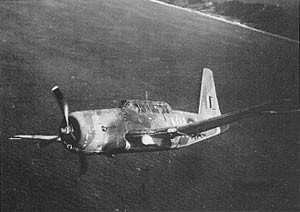
Aircraft wrecks are relatively common in Pt Phillip, but only a few have been located.
The Vultee Vengeance was a poorly performing dive bomber design bought for the RAAF because no-one else wanted it. Australia was so short of aircraft in the 1940s that it had to take anything. Consolidated Vultee was abandoning this design as obsolete even before it had seen combat, but they had to keep the workforce busy while they changed over to better designs. They were one of the few aircraft in plentiful supply during the more desperate days of WWII. US historian Eric Bergerud has written that by selling Australia Vengeances, the US Government “unloaded junk”.
USAAF serial number 41-31303 was given the number “A27-505” before being delivered to the RAAF on 24 December 1943. Between March and June 1944 this aircraft served with 25 Squadron RAAF. The Vultee Vengeance was regarded by most RAAF Airmen as unsafe for dive bombing. The Australian Government and RAAF were embarrassed by the rapid withdrawal from combat service of aircraft that had been acquired at considerable cost. After delivery to the RAAF’s Central Flying School at Point Cook on 29 November 1945, the aircraft was modified to be a target tug. Most pilots thought that they were not even safe enough for that task.
On the 6 March 1946, Vultee Vengeance “A27-505” was flown by Warrant Officer FO Knudson RAAF from South Australia. His observer, Warrant Officer LR Wastell RAAF was from Northcote in Victoria. They were towing a target for gunnery practice.
While flying over St Kilda the plane suffered an engine failure probably due to a loss of oil pressure. Vengeances were notorious for overheating. It was forced to make a near belly landing at Williamstown and ran into some nearby rocks. Knudson was later admitted to hospital with slight head injuries.

In July 1989 divers were directed to a strange anomaly on the seabed in about 10.5 metres of water off the Williamstown Football ground. A local can remember a salvage crew trying to winch the plane ashore and only succeed in tearing the engine off. The plane was somehow moved out from the shallows to where it rests now. There are two wings and part of the centre fuselage. The tail and engine are missing from the plane. The engine has since been found a few hundred metres away. The ends of the propeller are broken off and the engine is half buried in the mud bottom. One end of the right wing is missing and the end of the left wing is almost broken off. The plane seems to have been stripped of anything of value before being dumped as there are no instruments or seats. The visibility on the plane would rarely exceed two metres and once a few divers are down it is even less.

The area has other scraps of old wrecks nearby. The Kakariki was a steamer that was sunk in a collision with the steamer Carradale in 1937. The Kakariki was later cut up and moved to a place called the Blowhole off the old Rifle range. The Carmen was a wooden lighter broken up behind the old Williamstown rifle range in 1936.
